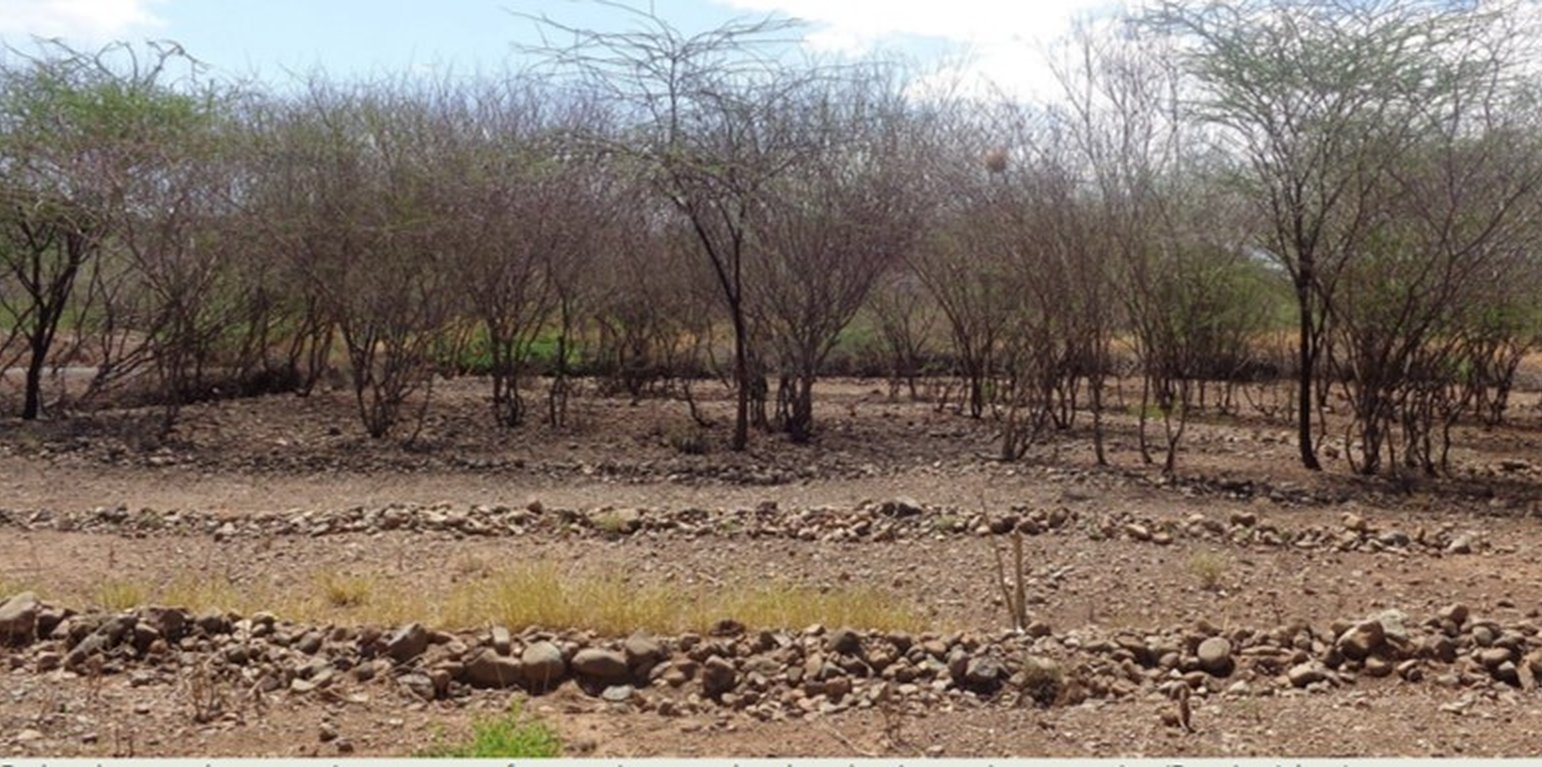



Area enclosures are sustainable land management (SLM) technologies implemented locally to rehabilitate land invaded by species such as Prosopis juliflora and prevent further re-invasion. They are crucial in preventing, controlling, and restoring of Prosopis management and are preferred for their cost-effectiveness, offering significant financial, environmental, and social benefits. Enclosures improve land aesthetics, diversify income sources in pastoral economies—such as through the sale of grass seeds and fodder—and help reduce conflicts over grazing land. In Baringo, several women have reported improved livelihoods and livestock acquisition from income generated by selling grass products.
The implementation of this SLM technology involves several steps: Established Prosopis trees are manually cut and uprooted using simple tools like machetes and hoes, with roots removed about 30 cm below the soil surface to prevent coppicing. This labor-intensive process can be hindered by inefficient equipment, potentially increasing costs. Barriers are then erected around the cleared land to restrict access by livestock and unauthorized individuals, often using tree branches for fencing. A tractor plows and ridges the land to create ridges that enhance water infiltration, with stone bunds placed along the edges to slow water flow and reduce soil erosion. Grass seeds are sown on ridge risers to form grass strips, with sowing timed for the rainy season to ensure optimal germination. While the Ministry of Agriculture provides seeds, local farmers may also sell them, as supply can sometimes fall short of demand. Additionally, native plants like acacia are intercropped with grass to offer extra ground cover and shade, reducing soil water evaporation.
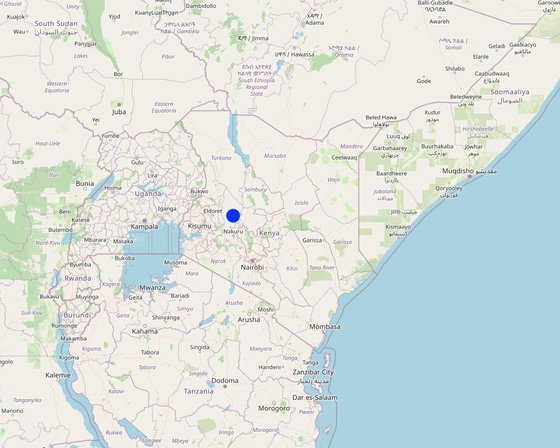
Байршил: Ngambo Sub-Location, Marigat Sub- County, Baringo County, Кени
Дүн шинжилгээнд хамрагдсан технологи нэвтрүүлсэн газрын тоо: нэг байршилд
Технологийн тархалт: тодорхой газар хэрэгжсэн/ жижиг талбайд төвлөрсөн
Хэрэгжилтийн огноо: 2019
Нутагшууллын төрөл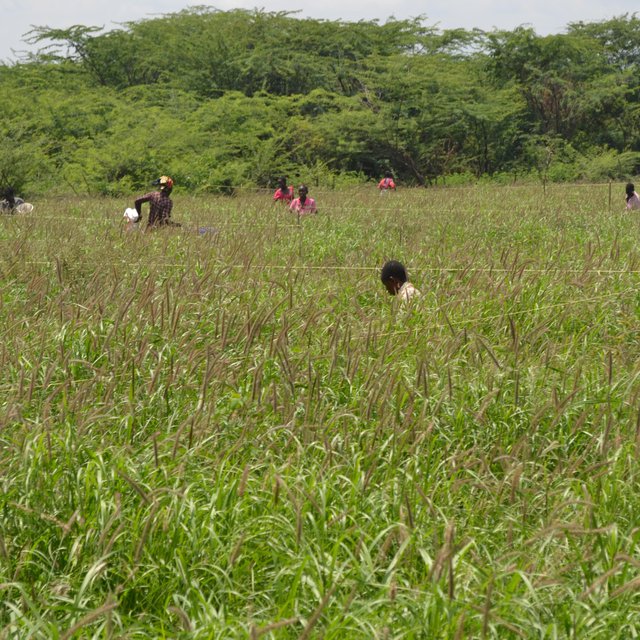
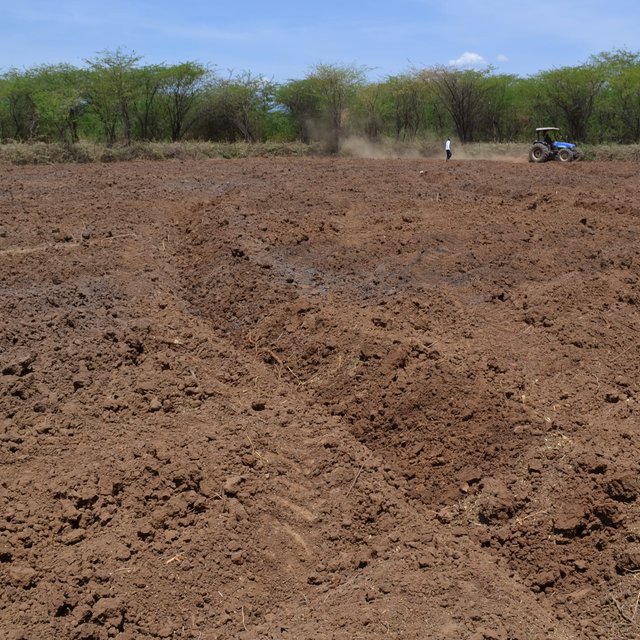







Техникийн үзүүлэлтүүд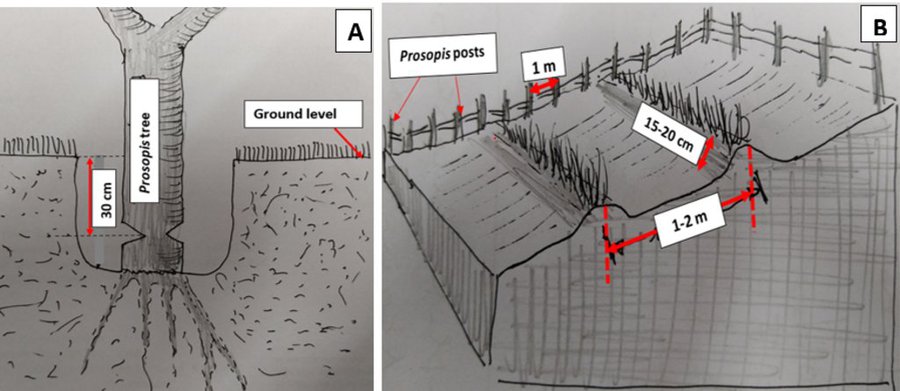
Зохиогч: Beatrice Adoyo
To uproot Prosopis trees, the soil around the stem is dug 30 cm deep, matching the maximum plowing depth of a tractor (Figure A). Depending on the stem's diameter, handheld tools like axes may be used to create a 90-degree notch on two opposite sides of the stem before cutting it with a chainsaw. A notch is a V-shaped cut or groove made on opposite sides of the tree's stem. This notch is created with an axe to weaken the tree and guide the direction in which it will fall when the tree is cut down with a chainsaw. The notch helps ensure that the tree falls in a controlled manner, reducing the risk of accidents and making the uprooting process more efficient.
Ridges are formed by a light tractor at a depth of 15 to 20 cm to minimize soil displacement and reduce erosion, with the depth adjusted according to the slope gradient. Shallower depths are often recommended for steeper slopes. The resulting furrows are spaced 1 to 2 meters apart and run parallel to the slope (Figure B) to help retain water and improve infiltration. Additionally, live fence poles are placed 1 meter apart to strengthen the enclosure. These live posts, made from tree stems, can grow roots and continue to thrive after being planted, helping to stabilize the soil, provide shade, and enhance the overall resilience of the enclosure. |
|||||||||||
| Зардлын нэр, төрөл | Хэмжих нэгж | Тоо хэмжээ | Нэгжийн үнэ (KES) | Зардал бүрийн нийт өртөг (KES) | Нийт дүнгээс газар ашиглагчийн төлсөн % |
| Хөдөлмөр эрхлэлт | |||||
| Uprooting of Prosopis trees | Man-days | 96.0 | 500.0 | 48000.0 | 100.0 |
| Fencing | Man-days | 38.0 | 500.0 | 19000.0 | 100.0 |
| Planting | Man-days | 30.0 | 100.0 | 3000.0 | 100.0 |
| Тоног төхөөрөмж | |||||
| Ploughing tractor | Hours | 6.0 | 420.0 | 2520.0 | 100.0 |
| Ridging | Hours | 6.0 | 420.0 | 2520.0 | 100.0 |
| Chain-saw hire | Fuel-tank used | 13.0 | 600.0 | 7800.0 | 100.0 |
| таримал материал | |||||
| Grass seeds | kg | 1.0 | 3000.0 | 3000.0 | |
| Технологи бий болгох нийт үнэ өртөг | 85'840.0 | ||||
| Зардлын нэр, төрөл | Хэмжих нэгж | Тоо хэмжээ | Нэгжийн үнэ (KES) | Зардал бүрийн нийт өртөг (KES) | Нийт дүнгээс газар ашиглагчийн төлсөн % |
| Хөдөлмөр эрхлэлт | |||||
| Weeding | Man-hour | 90.0 | 100.0 | 9000.0 | 100.0 |
| Ridging | Man-hour | 60.0 | 100.0 | 6000.0 | 100.0 |
| Harvesting | Man-hour | 50.0 | 100.0 | 5000.0 | 100.0 |
| Stone bunds | Man-hour | 6.0 | 100.0 | 600.0 | 100.0 |
| Технологийн арчилгаа/урсгал үйл ажиллагаанд шаардагдах нийт үнэ өртөг | 20'600.0 | ||||
ГТМ хэрэгжихээс өмнөх тоо хэмжээ: 0 bales of fodder/ha
ГТМ хэрэгжиснээс хойшхи тоо хэмжээ: 32 bales of fodder/ha
Income from fodder: 32 x 300 KES = 9600 KES
Enhanced livestock productivity due to availability of high quality fodder across seasons
ГТМ хэрэгжихээс өмнөх тоо хэмжээ: 0 products
ГТМ хэрэгжиснээс хойшхи тоо хэмжээ: 3 products (fodder, grass seeds, and charcoal, the latter being optional)
Charcoal production only during establishment, when prosopis trees are removed
Grassland restoration ensures improved ground cover which reduces soil erosion
ГТМ хэрэгжихээс өмнөх тоо хэмжээ: 0 bags of charcoal
ГТМ хэрэгжиснээс хойшхи тоо хэмжээ: 37 bags of charcoal
Prosopis trees uprooted during land preparation are used for charcoal production.
ГТМ хэрэгжихээс өмнөх тоо хэмжээ: 0 KES
ГТМ хэрэгжиснээс хойшхи тоо хэмжээ: 95,300 KES
ГТМ хэрэгжихээс өмнөх тоо хэмжээ: 0
ГТМ хэрэгжиснээс хойшхи тоо хэмжээ: KES 45,600
ГТМ хэрэгжихээс өмнөх тоо хэмжээ: 0 sources of income
ГТМ хэрэгжиснээс хойшхи тоо хэмжээ: 3 income sources from sale of fodder, grass seeds, and charcoal
Activities involved in this technology are tedious especially during land preparation and harvesting
A number of women groups have been established, whose members collectively support each other during implementation of the SLM.
Most of the practicing households have learnt of the SLM from their neighbors and community group members, e.g., women groups. This enhances awareness creation on land degradation and respective management options.
Grassland restoration results into self sufficient household minimizing competition for communally shared grazing land hence minimizing conflicts.
Restored lands are often covered by grass which lowers the impact of rain water on the soil hence reducing soil erosion.
Mbaabu et al. 2020 (https://doi.org/10.1038/s41598-020-77126-7) have demonstrated that carbon sequestration by grasslands is comparable to that of Prosopis. Therefore, substituting Prosopis with grass is unlikely to significantly affect carbon sequestration benefits. This suggests that replacing Prosopis with grass can maintain carbon sequestration benefits while reducing the negative impacts of Prosopis, resulting in a net positive gain.